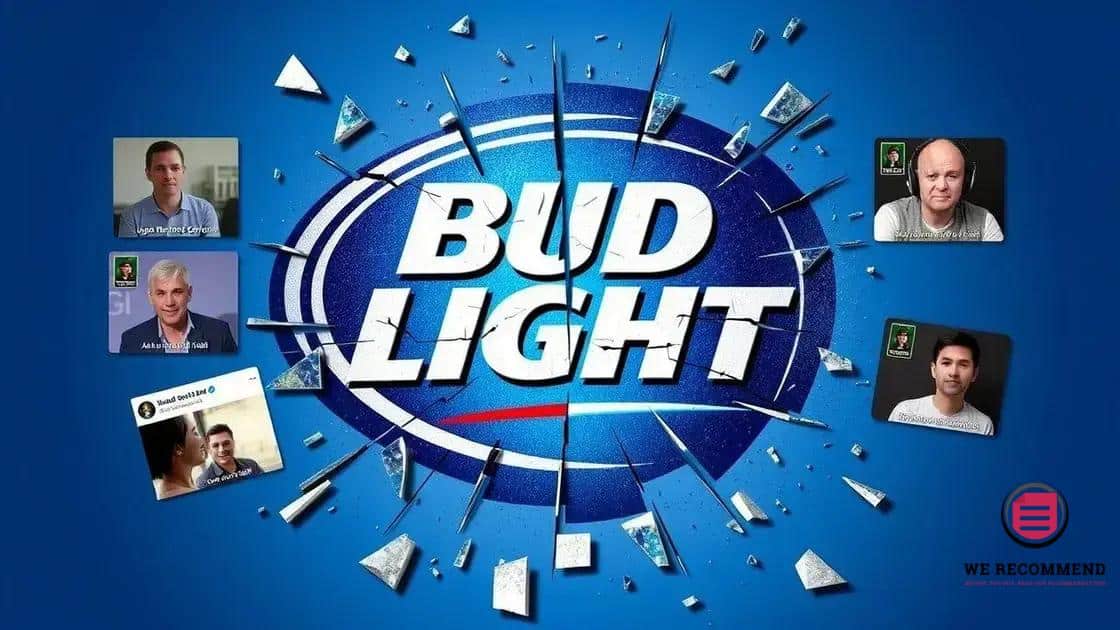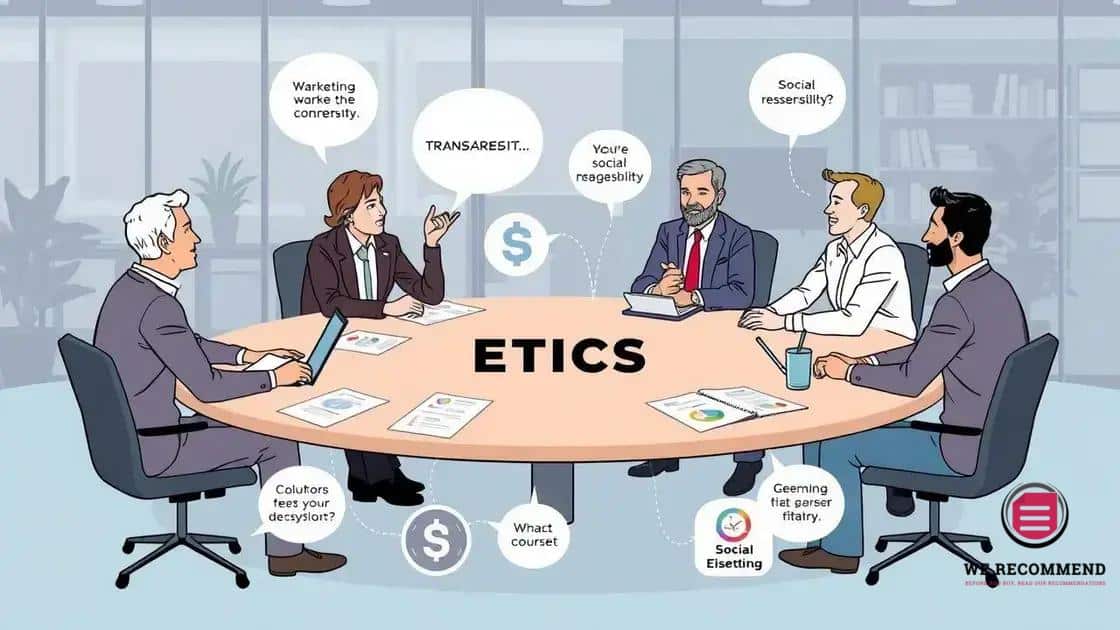Bud Light marketing controversy: what happened and why it matters

Anúncios
The Bud Light marketing controversy highlights the importance of aligning brand messages with consumer values, underlining the need for ethical marketing and audience engagement to rebuild trust after missteps.
The Bud Light marketing controversy has sparked significant debate among consumers and brands alike. Many are left wondering how this incident will shape advertising strategies moving forward. Let’s dive into what unfolded.
Anúncios
Understanding the bud light marketing controversy
The Bud Light marketing controversy began when the brand launched a campaign that sparked unexpected backlash. This incident highlighted the challenges brands face in today’s highly sensitive market.
Anúncios
Specifically, the controversy arose from the use of certain promotional imagery and messaging that many consumers found polarizing. Such reactions underscore how important it is for brands to understand their audience.
Key Events of the Controversy
Initial reactions to the campaign were swift, with social media platforms buzzing with both support and criticism. The brand’s decision to target a specific demographic raised eyebrows and led to heated debates.
As the situation escalated, Bud Light faced public calls for boycotts, which amplified discussions around consumer loyalty and brand alignment with personal values.
Impact on Marketing Strategies
This controversy has profoundly impacted Bud Light’s marketing strategies. It serves as a reminder that companies must carefully consider their messaging and potential audience reactions.
Brands should focus on authenticity and ensure that their campaigns resonate positively with their core consumers. Additionally, the fallout from such incidents can lead to re-evaluating existing marketing plans.
For more insights into marketing strategies and consumer dynamics, visit Ad Age.
Key events leading to the controversy
The key events leading to the controversy surrounding Bud Light began with the launch of a new marketing campaign that aimed to engage younger consumers. This campaign included unique graphics and messaging that attempted to resonate with a specific demographic. However, the approach backfired.
Social media was ablaze with reactions almost immediately. Supporters praised the brand’s fresh perspective, while critics condemned it for being out of touch.
One significant event was when popular influencers shared their thoughts on the campaign. This created a ripple effect, as their followers began to voice their opinions across various platforms.
Timeline of Major Events
- Launch of the marketing campaign.
- Initial positive and negative reactions on social media.
- Involvement of key influencers who shaped public perception significantly.
Each of these events played a crucial role in escalating the controversy. The brand soon realized that not all publicity is good publicity, leading to further discussions about their marketing strategies.
For more context on consumer reactions and marketing dynamics, you may refer to Marketing Week.
Public reactions to the bud light campaign
The public reactions to the Bud Light campaign showcased a wide range of opinions that illuminated the polarized nature of the brand’s messaging. Many consumers took to social media to express their thoughts.
Some individuals praised the campaign for its creativity and willingness to engage with contemporary issues. They appreciated Bud Light’s attempt to connect with younger audiences through relevant topics.
On the other hand, a significant portion of the audience felt that the campaign was disrespectful or out of touch. This led to negative comments and calls for boycotts.
Examples of Reactions Online
- Supporters shared posts highlighting the campaign’s innovative approach.
- Critics voiced concerns about the brand’s authenticity and values.
- Many influencers weighed in, further amplifying the conversation.
The backlash was swift, and the discussions often spanned various platforms, from Twitter to Instagram. These reactions illustrate the volatile relationship between brands and their consumers in a rapidly changing landscape.
For more on the implications of consumer reactions in marketing, check out Forbes.
Impact on brand identity and image

The impact on brand identity and image following the Bud Light controversy has been significant. The incident put the brand under intense scrutiny, affecting how consumers perceive it.
Initially, Bud Light’s reputation was built on qualities like fun, camaraderie, and reliability. However, the backlash shifted consumer attitudes, leading many to view the brand as controversial.
Brands today must navigate a minefield of consumer expectations. This situation illustrates how quickly brand identity can be reshaped by public perception.
Key Changes in Brand Image
- Increased skepticism from traditional customers.
- Challenges in retaining younger audiences who may have different priorities.
- Need for the brand to reassess its marketing strategies to restore credibility.
As brands evolve, they must focus on being authentic and aligning their messages with consumer values. This is crucial for rebuilding trust in the wake of a controversy.
For a deeper look at brand management and identity challenges, visit Harvard Business Review.
Comparative analysis with other marketing missteps
A comparative analysis with other marketing missteps shows how the Bud Light controversy aligns with past failures in brand communication. Examining these parallels can provide valuable insights for marketers.
Many brands have faced backlash for campaigns that were seen as offending or alienating certain segments of their audience.
For instance, when Pepsi released its controversial ad featuring Kendall Jenner, it received widespread criticism for trivializing serious social issues. Like Bud Light, it showed a disconnect between brand intentions and consumer perceptions.
Key Examples of Marketing Missteps
- Pepsi and the Kendall Jenner ad’s backlash for insensitivity.
- Dove’s misjudged campaign that faced criticism for racial insensitivity.
- Gillette’s advertisement that sparked divisive opinions regarding masculinity.
These cases illustrate that brand identity can be quickly tarnished when marketing campaigns fail to resonate with the intended audience. It emphasizes the importance of consumer insights and cultural awareness in advertising.
To explore more about effective marketing strategies and pitfalls, visit Marketing Land.
Lessons learned from the bud light debacle
The lessons learned from the Bud Light debacle highlight the importance of understanding consumer sentiment and brand positioning. Many takeaways can help brands avoid similar pitfalls in the future.
One important lesson is the need for consistent messaging that aligns with a brand’s identity. When campaigns stray too far from core values, they risk alienating loyal customers.
Another key takeaway is the significance of audience research. Brands must invest in understanding their target demographic and how they react to certain themes and messages.
Critical Lessons for Brands
- Align marketing efforts with consumer values and expectations.
- Engage in thorough audience research before launching campaigns.
- Be prepared to respond proactively to public feedback.
Companies that learn from such incidents can adapt their strategies to remain relevant and trusted in the eyes of consumers. For more insights on effective brand strategies, check out Forbes.
Future of bud light’s marketing strategy
The future of Bud Light’s marketing strategy will likely focus on rebuilding trust and reconnecting with its core audience. After the recent controversy, it’s essential for the brand to take measured steps in its advertising tactics.
One strategy could involve a return to traditional values, emphasizing camaraderie and celebration. Engaging consumers through relatable content may help repair the brand’s image.
Additionally, involving consumers in the marketing process through interactive campaigns can create a sense of community and loyalty. This could include social media initiatives or partnerships with local events.
Potential Changes to Marketing Approaches
- Increased focus on consumer feedback to shape campaigns.
- Collaborations with diverse influencers to reach broader audiences.
- Content that celebrates shared experiences and connects emotionally with consumers.
Adaptation to current trends while staying true to brand identity will be crucial for Bud Light. For more insights into evolving marketing strategies, visit MediaPost.
Expert opinions on marketing ethics and responsibilities

Expert opinions on marketing ethics and responsibilities emphasize the critical need for brands to act with integrity in their campaigns. Following the Bud Light controversy, many marketing professionals are urging brands to reassess their approaches.
One common viewpoint is that ethical marketing should be a foundational principle. This includes being truthful in messaging, steering clear of manipulation, and valuing consumer welfare above profit.
Experts also stress the importance of understanding societal impact. Marketing should reflect a company’s commitment to social responsibility and be sensitive to current events and cultural values.
Key Ethical Considerations
- Transparency in advertising to build consumer trust.
- Engaging with communities to understand their perspectives and values.
- Critically evaluating the potential implications of marketing messages.
These principles can help brands avoid pitfalls and foster lasting relationships with their consumers. For deeper insights on marketing ethics, refer to American Marketing Association.
In summary, navigating the complexities of brand marketing
The recent Bud Light marketing controversy serves as a powerful reminder of how crucial it is for brands to align their messaging with the values and expectations of their consumers.
Brands must prioritize transparency, audience engagement, and ethical marketing practices to avoid similar pitfalls in the future. By learning from past mistakes, companies can rebuild trust and maintain strong connections with their audience.
As the marketing landscape continues to evolve, those who adapt thoughtfully and responsibly will likely emerge as leaders in their industries.
Ultimately, successful marketing is not just about selling products; it’s about fostering relationships grounded in respect and shared values.
FAQ – Frequently Asked Questions about the Bud Light Marketing Controversy
What led to the Bud Light marketing controversy?
The controversy arose from a marketing campaign that many consumers perceived as polarizing, leading to widespread backlash on social media.
How can brands learn from the Bud Light situation?
Brands can learn to prioritize ethical marketing, align their messaging with consumer values, and engage in thorough audience research.
What role does consumer feedback play in marketing?
Consumer feedback is crucial for brands to understand public sentiment and adjust their strategies to meet changing expectations.
How can Bud Light rebuild its brand trust?
Bud Light can rebuild trust by focusing on transparency, aligning its campaigns with core values, and actively engaging with its audience.






